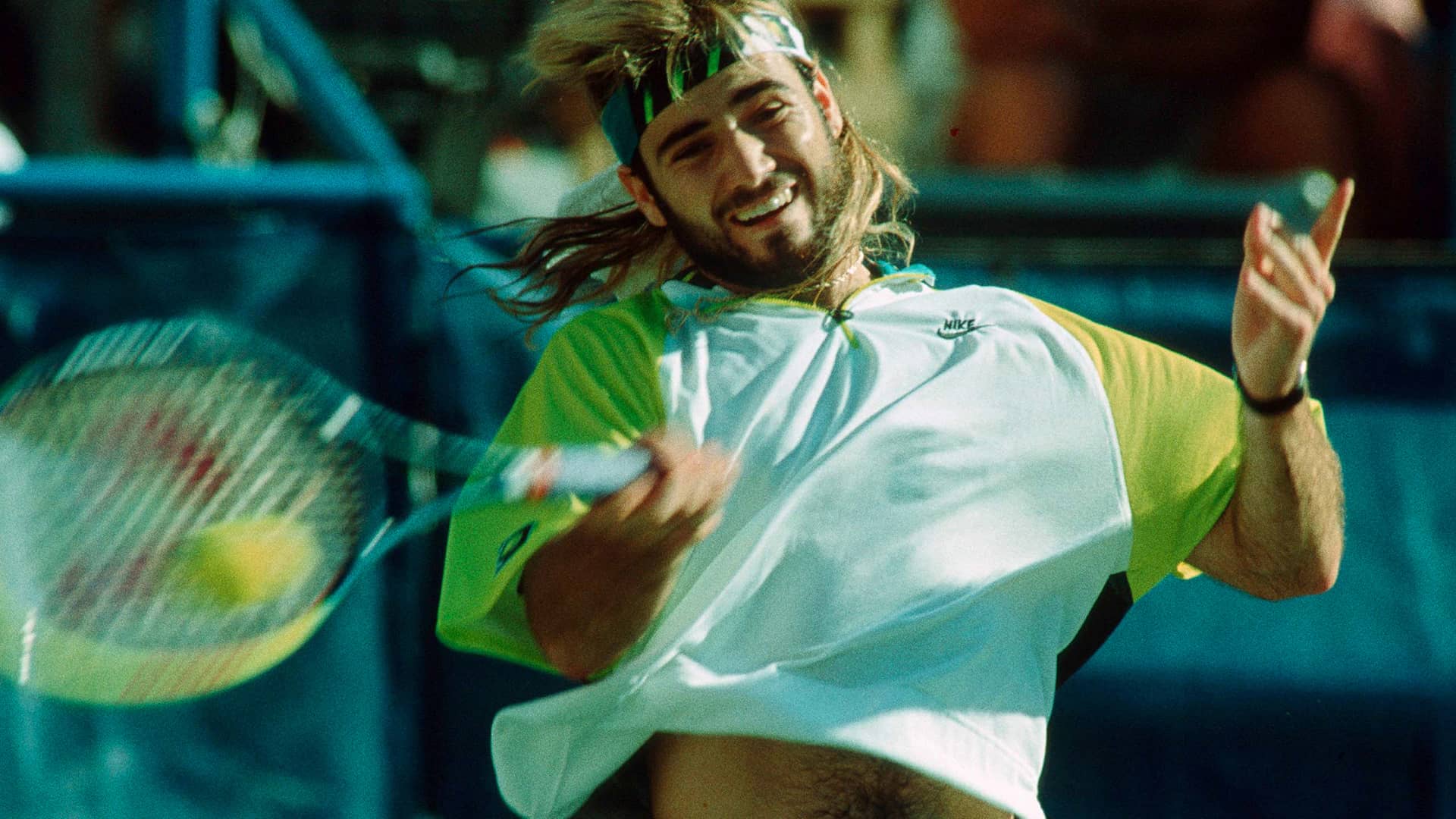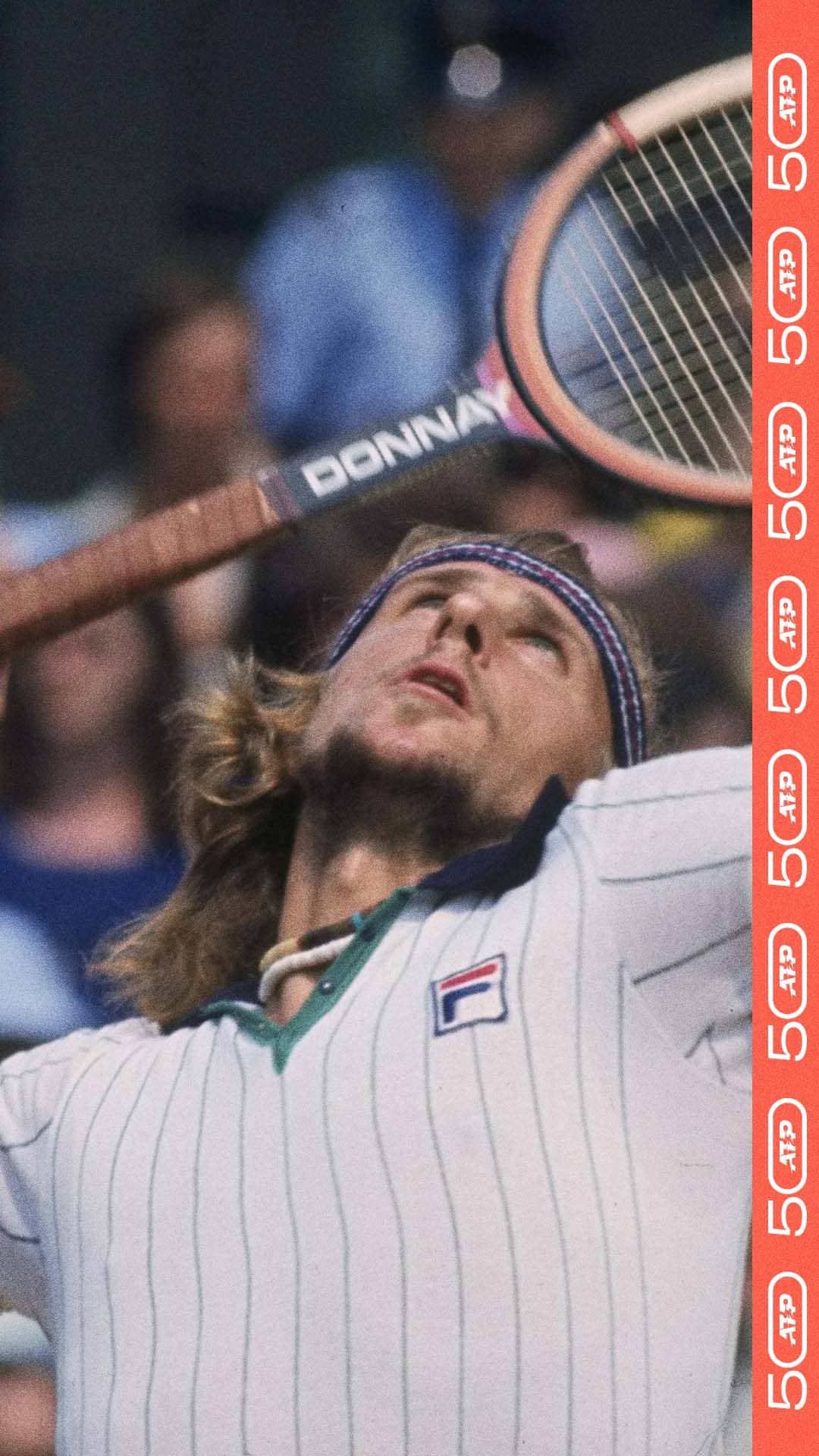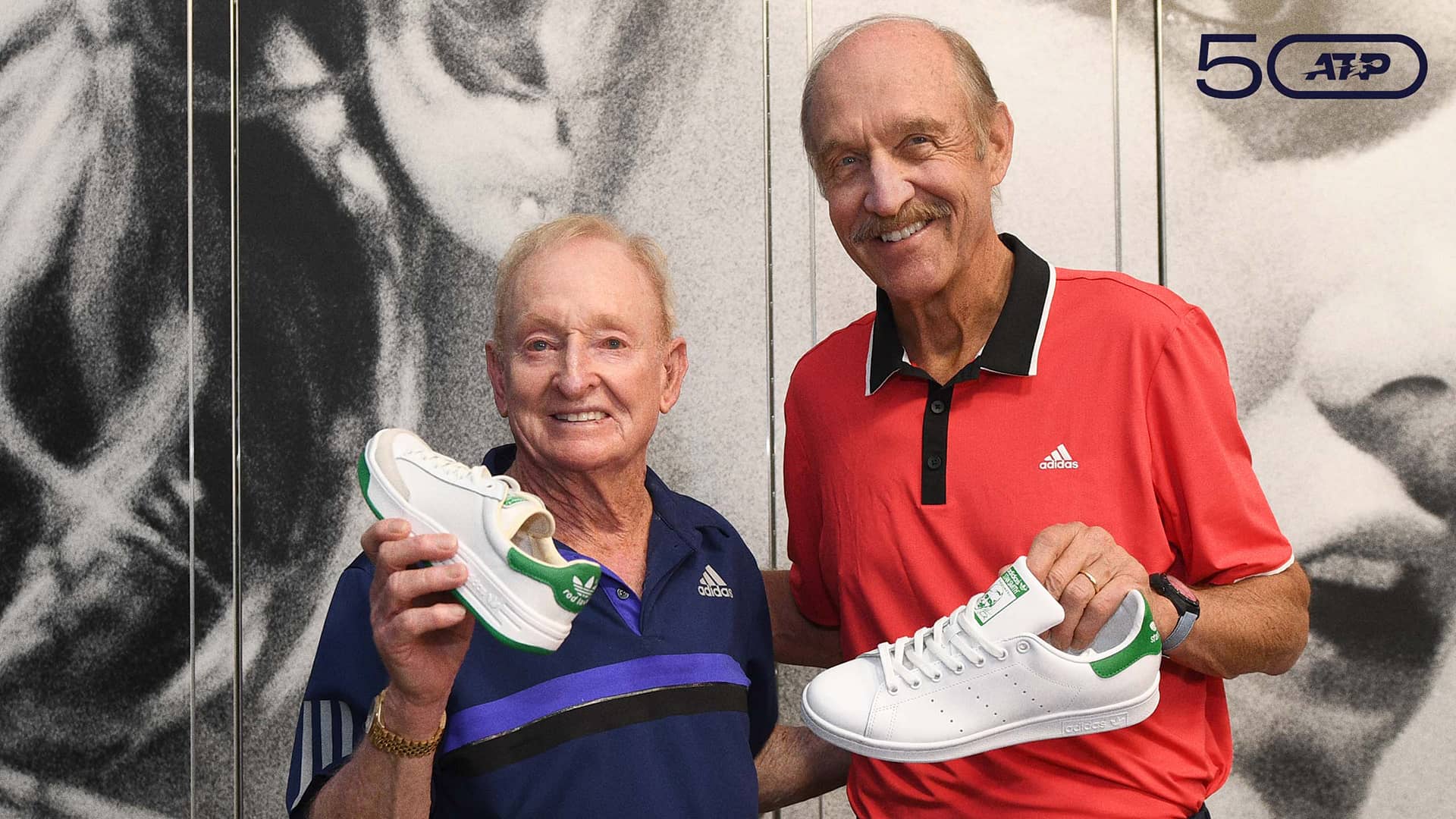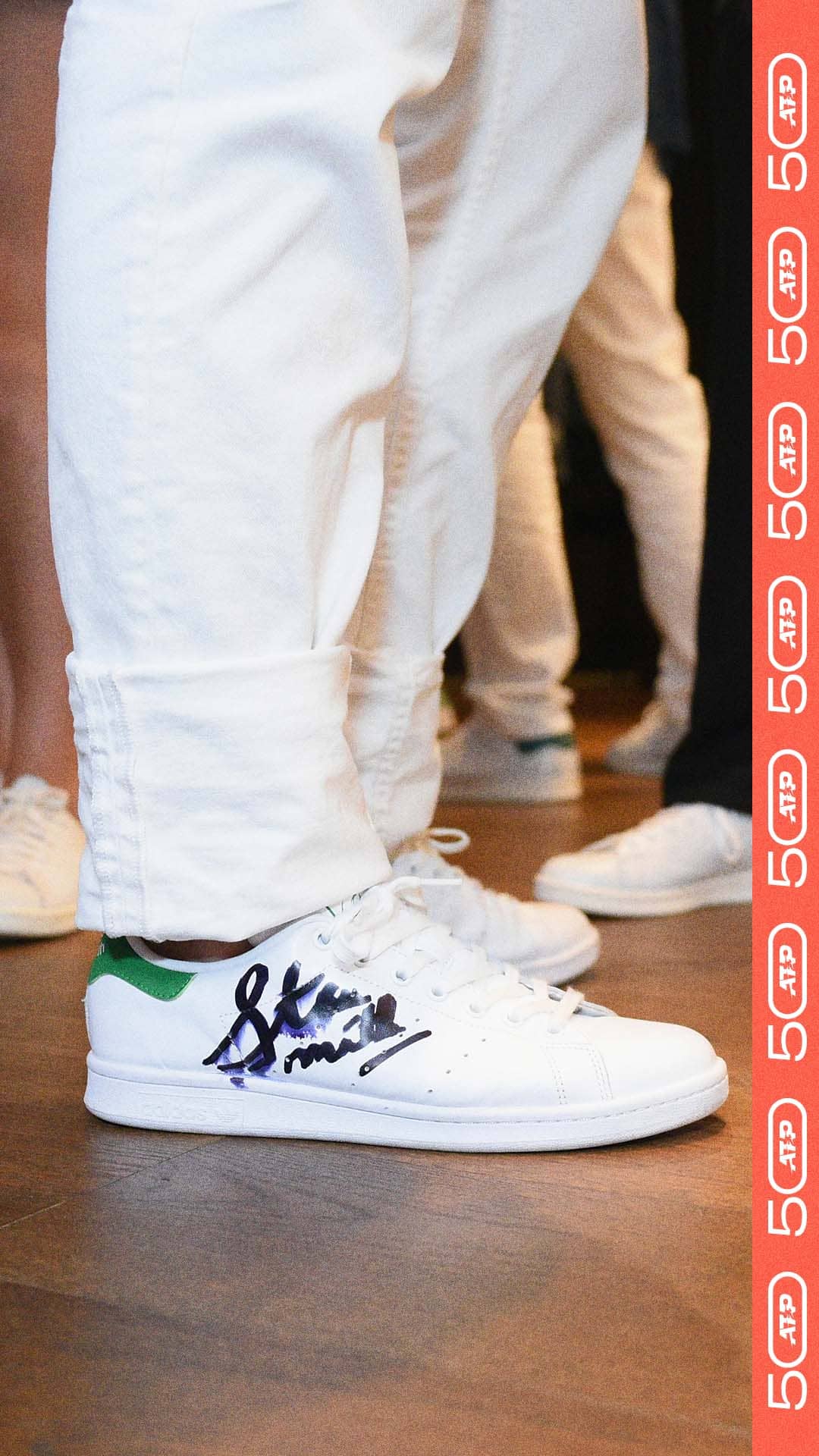ATP 50:
Fabulous Fashion
Memorable Kits, Cuts & Kicks In ATP History

ON THE CUTTING EDGE
Just as playing styles evolve over time, fashion never stands still. Tennis fashion in particular shines bright in the sporting world, with a heavy cultural influence off the court.
Throughout the history of the ATP, players have been free to express individuality in their games and their match attire. From the wildly popular Stan Smith sneakers, to Andre Agassi’s boundary-pushing match kits in the 1990s, to the iconic looks and logos of Roger Federer and Rafael Nadal today, tennis has never lacked for larger-than-life statements in style.
In the 50 years of the ATP, the tennis world has remained on fashion’s cutting edge.
Bjorn Borg. Photo Credit: Allsport UK
Bjorn Borg. Photo Credit: Allsport UK
Rod Laver and Stan Smith. Photo Credit: Vince Caligiuri/Getty Images
Rod Laver and Stan Smith. Photo Credit: Vince Caligiuri/Getty Images
Stan Smith's Iconic Sneakers
The famous adidas Stan Smith sneakers were first created for French player Robert Haillet in 1965, but the classic kicks rocketed into mainstream prominence on the feet of the American, who finished the 1972 season as World No. 1. The International Tennis Hall of Famer’s face was printed on the shoes as adidas sought to expand its presence in the United States.
“When I was playing, I would look down, as I'd be returning a serve, and see my shoes and see my face looking at me,” Smith said in a 2021 GQ interview. “And so I'd always think that I should be a good player — I'm wearing shoes with my face on, that doesn't happen for just anyone.”
The understated design of the first leather tennis shoes made them a hit both on the tennis court and in casual wear. While tennis sneakers have advanced to meet the demands of the modern game, the Stan Smith sneakers remain popular off the court and have been worn by the likes of Paul McCartney, Kate Middleton, Harrison Ford and Barack Obama.
McEnroe & Borg's '70s Style
John McEnroe and Bjorn Borg contested one of tennis’ most enduring rivalries in the late 1970s and early 1980s, their contrasting personalities of fire and ice enlivening the matchup. But when it came to on-court fashion, the two had a lot in common.
As was the tennis fashion in the 70s, collared shirts and short shorts were in, with headbands doing their best to contain the shaggy hairdos of the era.
“I don’t think at the time that we recognised how much of a defining era the 1970s would become,” Borg said in a 2022 GQ interview. He named Argentine Guillermo Villas and Italy’s Adriano Panatta as his best-dressed rivals of the era.
The Swede’s famous pinstriped Fila polo is one of the most memorable styles of the period. Inspired by Babe Ruth’s New York Yankees pinstripes, the look remained synonymous with Borg and was paid homage by Alexander Zverev at the 2017 US Open.
Stan Smith sneakers. Photo Credit: Andrew Toth/Getty Images for adidas Originals
Rod Laver and Stan Smith. Photo Credit: Andrew Toth/Getty Images for adidas Originals
John McEnroe. Photo Credit: Tony Duffy/Getty Images
John McEnroe. Photo Credit: Steve Powell/Getty Images
Stefan Edberg. Photo Credit: Clive Brunskill/Allsport
Stefan Edberg. Photo Credit: Clive Brunskill/Allsport
Tennis Whites
The original tennis style began for practical reasons: white clothing reflected the sun and hid sweat stains long before the days of moisture-wicking fabrics.
But even at Wimbledon, where white clothing has been required since the tournament’s first edition in 1877, styles have changed through the years.
Flashes of colour were common at The Championships through the history of the ATP, with Stefan Edberg’s elegant splash of yellow, green and red a memorable look during his run to the 1987 semi-finals.
But such fashion touches are no longer permitted on the London lawns; a 2014 dress code update now holds that trims of colour must be no more than one centimetre in width.
A Tip Of The Cap
While headbands have remained en vogue from the days of Borg and McEnroe through to Federer and Nadal today, caps have also been an essential part of the tennis wardrobe through the years.
Opting for function over fashion on his way to the 1990 Australian Open title, Ivan Lendl famously wore a workmanlike, tailed cap to protect his neck from the Melbourne sun.
Eleven years later, Lleyton Hewitt and Andy Roddick sported matching backwards hats in a memorable five-set US Open quarter-final, with the Australian going on to win his first Grand Slam title that fortnight against Pete Sampras. Roddick later popularised the tennis visor before coach Brad Gilbert banned it at their first practice, saying it diminished his charge's intimidation factor. The new look proved successful, as Roddick won the 2003 US Open in a trucker cap.
Tim Henman. Photo Credit: Clive Brunskill/Getty Images
Stefan Edberg. Photo Credit: Clive Brunskill/Allsport
Ivan Lendl. Photo Credit: Bongarts/Getty Images
Ivan Lendl. Photo Credit: Bongarts/Getty Images
Andre Agassi. Photo Credit: Mike Powell/Allsport
Andre Agassi. Photo Credit: Mike Powell/Allsport
Andre Agassi. Photo Credit: Gary Prior/Allsport
Andre Agassi. Photo Credit: Mike Powell/Allsport
Andy Roddick. Photo Credit: Stan Honda/AFP via Getty Images
Andy Roddick. Photo Credit: A. Messerschmidt/Getty Images
Agassi: "Image Is Everything"
While Andre Agassi was not expecting to be forever linked to the infamous tagline he spoke in a 1989 Canon commercial, the American certainly came to play when it came to fashion.
Agassi became a style icon for his ever-changing look throughout his career. His denim jean shorts made headlines at the 1988 US Open, paired with a crisp, white, collared shirt. He made the semi-finals that year and reached the New York final two years later in a flashy Nike outfit with bright yellow sleeves and a headband to tame his famous mullet — a hairstyle replicated more recently by another American in J.J. Wolf.
In 1995, Agassi shaved his head (he later revealed he had been wearing a wig) and won the Australian Open in a pirate-inspired match kit with a maroon bandana and earrings.
“A lot of people at the time thought I was expressing myself, but I was really exploring myself,” Agassi said in a 2014 interview. “And I wasn’t scared to take people along for that ride. If it meant something greater in a certain industry, it was definitely by accident.”
Later in his career, Agassi was more subdued but still fashion-forward. In his classic 2001 US Open quarter-final against Pete Sampras, he memorably sported a sleek all-black kit, in stark contrast to his rival’s all-white ensemble.
Striking Shirts: Roddick, Fognini & More
As heavier fabrics gave way to lighter, sweat-wicking materials, there was also another shift in on-court fashion. The traditional collared tennis polo will never go out of style, but since the early 2000s, no-collar shirts have risen to prominence among the game’s best.
Many players and clothing brands have made those shirts a canvas for artistic expression throughout the years. One year after he won the 2003 US Open, Roddick returned to his home Slam in a shirt modelled after the New York City subway system.
Players often bring out the best from their wardrobe for the US Open, hoping to make their mark in one of the fashion capitals of the world. That was again the case in 2018 when Fabio Fognini sported a Hydrogen-made kit that paid tribute to the stars and stripes of the United States, complete with red and white striped shorts that would have made Uncle Sam proud.
Another standout brand in recent years is Lalá Sportswear. Founded by Sabrina Sielecki, the wife of three-time tour-level doubles champion Ariel Behar, the brand produces tennis shirts with unique designs ranging from llamas to jellyfish to ghosts.
Rafael Nadal. Photo Credit: Clive Brunskill/Getty Images
Rafael Nadal. Photo Credit: Clive Brunskill/Getty Images
Nadal Arrives On The Scene In Style
Rafael Nadal announced himself as one of the game’s best in 2005, when he won his first four ATP Masters 1000 titles (Monte Carlo, Rome, Montreal, Madrid) and the first of his 14 Roland Garros crowns.
The Spaniard, who celebrated his 19th birthday by defeating Roger Federer in the Roland Garros semi-finals, did it all in an iconic kit that combined a sleeveless shirt with capri-style pants that went down to his shins. The outfit evolved with many colours over the years, but the orange and green sleeveless tees he wore during the 2005 European clay swing — both paired with white bottoms — stand out for their significance in both fashion and tennis history.
After moving away from the sleeveless look for much of the 2010s, Nadal has brought back the style in recent years, now complete with his famous ‘Raging Bull’ logo.
“I have small issues when I’m playing in very hot conditions when I hit my forehand, so I like to play without the sleeves,” Nadal told John McEnroe at the 2019 Australian Open. “It makes me feel younger again.”
The stylish James Blake has also modelled sleeveless shirts to great effect throughout his career, with Carlos Alcaraz and Alexander Zverev among those sporting the look more recently.
Federer's Timeless Look
Picking a signature look from Roger Federer’s long career is a tall task, but the Swiss has always oozed elegance and class both in his game and his style.
Perhaps the Wimbledon whites, in which he won eight titles at The Championships, are most memorable — particularly the gold trim he sported at SW19 in 2007 as he won his fifth straight London trophy, strolling out onto the court in a white blazer jacket for the final.
The Swiss has also enjoyed commemorating his various title triumphs with symbolic designs on his sneakers, a trend that has become mainstream in recent years. In 2018, Federer played with the London skyline on his shoes at Wimbledon, with the number eight incorporated into the design to represent his record trophy haul at the event. He also sported the New York skyline on his sneakers at the 2010 US Open and played in Air Jordan-inspired shoes in Flushing in 2014.
“I think storytelling is really important in sports,” Federer told Jim Courier on his way to the 2018 Australian Open title, discussing the image of Melbourne’s iconic Flinders Street Railway Station on his kicks. “Where we come from, what we do and the places we play in.”
Federer’s ‘RF’ logo is iconic in its own right. Originally created by his wife Mirka, it has become synonymous with the Swiss legend, who has used it with both Nike and Uniqlo.
His 2018 switch from Nike to Uniqlo made worldwide headlines, and he consulted with good friend and Vogue editor-in-chief Anna Wintour as he weighed up the move.
“I really wanted to make the best apparel, the best-looking apparel for a tennis player in recent years,” Federer said of his move to the Japanese brand. “I want to re-do that, and recreate the coolest things with Uniqlo.
“I thought it would be a wonderful step into new endeavours, an entrepreneurial stage, incorporating philanthropy, innovation and new regions of the world.”
Rafael Nadal. Photo Credit: Michael Steele/Getty Images
Rafael Nadal. Photo Credit: Clive Brunskill/Getty Images
Roger Federer's Nike sneakers. Photo Credit: Matthew Lewis/Getty Images
Roger Federer. Photo Credit: Paul Gilham/Getty Images
Roger Federer. Photo Credit: Paul Gilham/Getty Images
Roger Federer. Photo Credit: Paul Gilham/Getty Images
Athletes As Creators
As players like Federer, Novak Djokovic and Andy Murray have become international stars, they have used their influence to become part of the design process for the high-performance gear they wear on the court.
Federer partnered with Swiss shoemakers On and helped create his own signature shoe for the brand. Similarly, Djokovic provided insights to Asics to help the Japanese brand design his signature shoe, the Court FF Novak.
While Murray may not have his own sneaker line, he has had great influence over his ‘AMC’ clothing collection with British brand Castore.
“I work with the AMC designers on every piece, with technical performance at the heart of the process,” Murray said. “It's important that the kit performs under the toughest conditions. I really enjoy testing it, giving my feedback and being a part of the design process.”
Novak Djokovic. Photo Credit: Darrian Traynor/Getty Images
Novak Djokovic. Photo Credit: Darrian Traynor/Getty Images
Daniil Medvedev. Photo Credit: Lacoste
Daniil Medvedev. Photo Credit: Lacoste
Lacoste:
"The Crocodile"
Since the turn of the century, Lacoste has outfitted some of the ATP's best players, including World No. 1s Roddick, Djokovic and Daniil Medvedev.
The famous crocodile logo was traditionally placed in understated fashion on Lacoste clothing, for apparel worn both on the tennis court and in the streets. But the French brand has gone bolder in step with modern times, splashing out with larger-than-life logos in recent years.
Medvedev — who rose to World No. 1 earlier this season in his Lacoste kit and sneakers — can be seen sporting one of the most recent iterations of the Lacoste crocodile above.
René Lacoste founded the brand in 1933 after a playing career that saw him rise to the top of the men's game. He earned the nickname "the crocodile" after admiring a crocodile leather suitcase in a shop window, and later had an early version of the iconic logo sewn onto the white jackets he wore as he walked onto court.
Lacoste was the first brand to display a visible logo on clothing. Originally designed in 1927, the mark has stood up as a symbol of elegance from long before the start of the ATP in 1972.
Novak Djokovic and Daniil Medvedev. Photo Credit: Matthew Stockman/Getty Images
Daniil Medvedev. Photo Credit: Lacoste






















